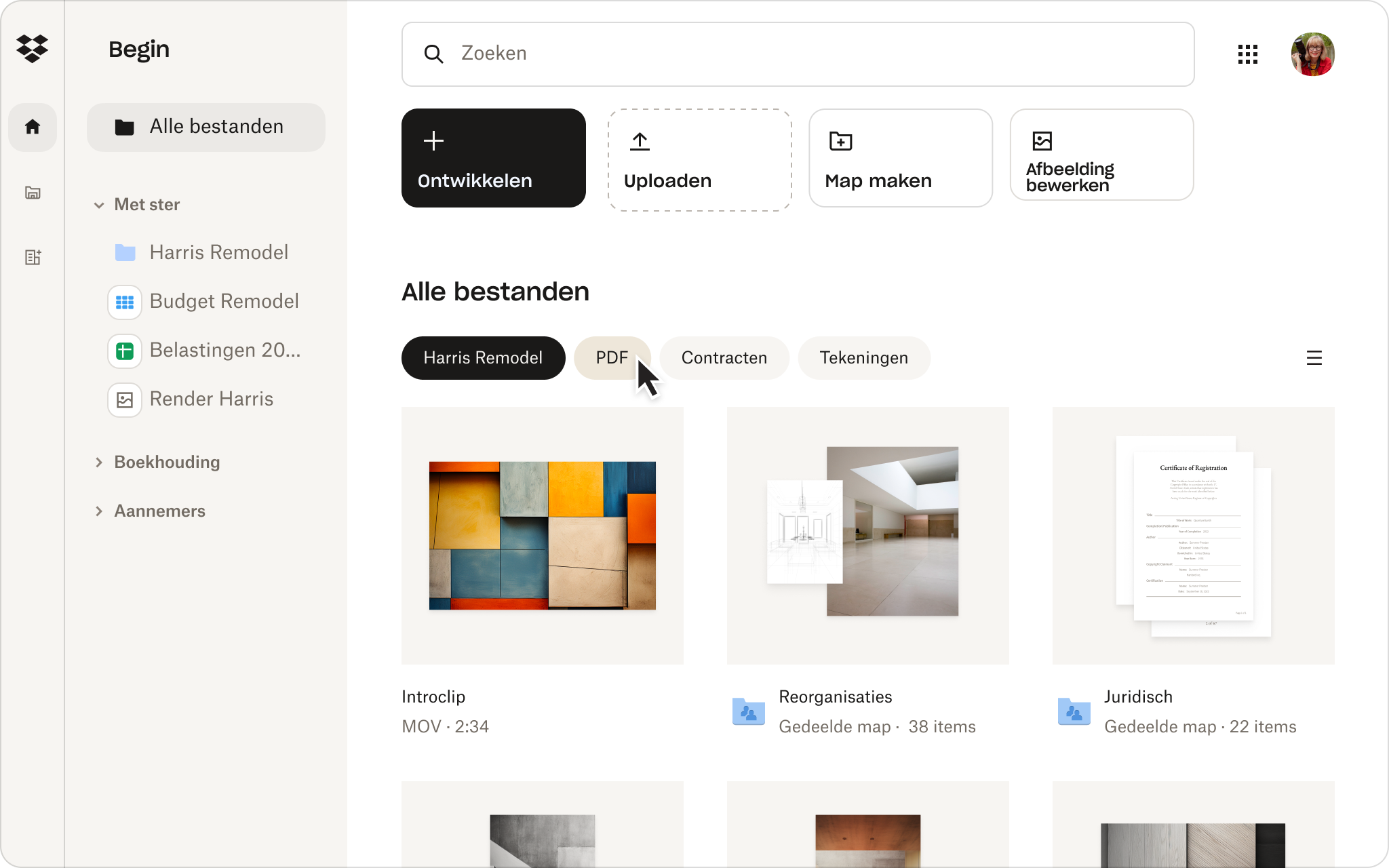Bent u het zat dat handmatige processen uw team vertragen? Ontdek hoe automatisering de efficiëntie en productiviteit van uw bedrijf radicaal kan verbeteren.
Automatisering verandert de manier waarop we werken. Volgens McKinsey zou voor 60% van de banen in de VS 30% of meer van de dagelijkse taken geautomatiseerd kunnen worden met behulp van huidige of binnenkort beschikbare technologieën. Dat staat gelijk aan het besparen van anderhalve dag werk per week.
Door automatisering te benutten, kunt u niet alleen efficiënter, productiever en consistenter werken, maar ook uw bedrijf opschalen en tegelijkertijd flexibel blijven.
In deze gids leggen we uit welke processen u moet automatiseren en hoe u dat in zes eenvoudige stappen kunt doen. Maar laten we eerst eens kijken waarom het überhaupt verstandig is om bedrijfsprocessen te automatiseren.
Waarom moet ik handmatige processen automatiseren?
De digitale transformatie zal in rap tempo doorgaan en bedrijven moeten zich aanpassen om bij te blijven. Enkele manieren waarop automatisering van bedrijfsprocessen voordelen biedt aan teams van alle omvang en uit alle sectoren:
- Verbeterde efficiëntie en productiviteit: aanzienlijkminder tijd en moeite nodig om handmatige taken uit te voeren
- Concurrentievoordeel:overtreed uw concurrenten door producten of diensten sneller en tegen lagere kosten te leveren
- Minder menselijke fouten: zorgvoor een betere consistentie en nauwkeurigheid en verminder de kans op fouten bij voorheen handmatige taken zoals gegevensinvoer, berekeningen en rapportage.
- Vereenvoudigde workflows: verminder knelpunten door onnodige stappen te elimineren, processen te consolideren en betere communicatie en samenwerking te faciliteren
- Betere naleving:standaardiseer nalevingsprocedures om ervoor te zorgen dat uw bedrijf zich houdt aan de relevante regelgeving en richtlijnen van uw sector.
Over het algemeen kan het automatiseren van bedrijfsprocessen zorgen voor een betere klantervaring, betere besluitvorming en minder inefficiëntie.
Welke processen moet ik automatiseren?
Enkele processen die gebruikers zouden kunnen overwegen te automatiseren, zijn:
- Bestanden en documenten verzenden
- Het verzamelen van e-handtekeningen
- Een back-up maken van bestanden
- Synchroniseren tussen apparaten
- Tijdsgevoelig delen van bestanden: stel vervaldatums in voor uw gedeelde links, zodat u de toegang tot bestanden en mappen niet handmatig hoeft in te trekken
Kijk daarnaast ook naar taken die tijdgevoelig zijn, nodig zijn voor naleving en controletrajecten, of van belang zijn voor het succes van andere processen of systemen, en die u als mogelijke kandidaten voor automatisering kunt beschouwen.

Hoe processen te automatiseren: een stapsgewijze handleiding
1. Definieer uw gewenste resultaten en doelstellingen
Soms is efficiëntie niet uw doel bij automatisering. Het kan ook gaan om een betere nauwkeurigheid, een beter moreel onder uw medewerkers, een soepelere onboarding-ervaring of het toevoegen van waarde aan uw bedrijfsproduct of -service.
De eerste stap naar het automatiseren van processen is simpelweg begrijpen wat u wilt bereiken met de wijziging. Zo kunt u prioriteiten stellen die aansluiten bij een verstandige strategie voor de manier waarop u uw automatisering wilt aanpakken en uitvoeren.
Documenteer deze doelen en bewaar ze op een plek waar iedereen in je team er toegang toe heeft. Probeer de Dropbox Paper-brainstormsjabloon om ideeën te ontwikkelen of een uitgebreid projectplan voor automatisering met je team te maken. Deze Paper-documenten en alle andere gedeelde bestanden en mappen worden veilig opgeslagen in Dropbox, waar je ze eenvoudig kunt delen en openen vanaf elk gekoppeld apparaat.
Hiermee bespaart u tijd en moeite, omdat meerdere gebruikers tegelijk toegang hebben tot bestanden en deze kunnen bewerken. Hierdoor is het niet meer nodig om bestanden handmatig te delen en versiebeheer toe te passen.
2. Identificeer handmatige of repetitieve taken die u vertragen
Bekijk en evalueer uw huidige processen om te bepalen welke taken of activiteiten meer praktische aandacht van uw team vereisen dan nodig is.
Houd er rekening mee dat niet alle taken of processen geautomatiseerd hoeven te worden. Mensen hebben op bepaalde vlakken nog steeds een voorsprong op technologie, bijvoorbeeld bij kwaliteitscontroles en het geven van feedback.
Automatisering is het meest effectief bij tijdrovende, repetitieve taken. Dit komt doordat er minder variatie is in deze activiteiten en er minder scenario's zijn waaraan de automatiseringstool zich moet aanpassen en waarvan hij kan leren.
3. Breng uw proces in kaart
Door te visualiseren hoe uw nieuwe geautomatiseerde proces gaat werken, kunt u een handig trainingsdocument maken voor nieuwe en bestaande collega's. Terwijl u dit creëert, is het belangrijk dat u input van anderen krijgt, vooral van degenen die dit proces regelmatig gebruiken.
Op dezelfde manier waarop u een workflow beoordeelt die gestroomlijnd moet worden, moet u het volgende overwegen:
- De betrokken medewerkers, systemen of tools
- De taken, stappen of activiteiten die nodig zijn om het gewenste resultaat van het geautomatiseerde proces te bereiken
- De informatie die nodig is om het geautomatiseerde proces draaiende te houden
- De trigger, actie, tijd of voorwaarde die het geautomatiseerde proces in gang zet
- De beoogde uitkomst of het resultaat van het geautomatiseerde proces

4. Implementeer uw automatiseringstool(s)
Zodra u uw behoeften hebt vastgesteld, is het tijd om uw automatiseringssoftware te introduceren.
Met Dropbox worden je bestanden automatisch gesynchroniseerd op al je apparaten. Zo heb je altijd de meest recente versie van een bestand bij de hand. Hierdoor is het niet meer nodig om bestanden handmatig over te dragen en bij te werken. Zo bespaar je tijd en verkleint je de kans op fouten.
En dat is nog niet alles: Dropbox biedt een hele reeks automatiseringshulpmiddelen en -functies waarmee u uw werk onder controle kunt houden:
- Blijf georganiseerd met dynamische filters en geautomatiseerde categorisering, sortering, naamgeving en tagging van mappen
- Automatiseer het volgen en rapporteren van gevoelige informatie met gegevensclassificatie
- Stroomlijn teamworkflows en verminder wisselen tussen contexten met integraties die automatisch gegevens synchroniseren tussen tools
- Organiseer automatisch het materiaal uit al je bestanden, apps en tabbladen met Dropbox Dash, aangestuurd door kunstmatige intelligentie
- Pas eenvoudig veelgebruikte PDF-formulieren aan en verstuur ze
5. Feedback verzamelen
Voordat u uw geautomatiseerde proces uitrolt naar het bredere team, vraagt u een teamgenoot, supervisor of iemand in een vergelijkbare positie als u in een ander team om zijn of haar mening. Zij kunnen het proces met een frisse blik bekijken en wellicht aangeven wat u over het hoofd hebt gezien.
Met Dropbox kunt u eenvoudig feedback verzamelen door een samenwerkingsplatform te bieden waarop teamleden moeiteloos toegang hebben tot gedeelde documenten en bestanden. Gebruikers kunnen direct opmerkingen op bestanden achterlaten, waardoor er in realtime discussies en suggesties kunnen plaatsvinden. Deze functie zorgt voor gestroomlijnde communicatie, zodat feedback overzichtelijk en direct beschikbaar is.
Als je team beter leert met visuele hulpmiddelen dan met tekst, kun je een schermafbeelding of video van je nieuwe proces delen ter beoordeling. Met Dropbox Replay kunnen je collega's vervolgens de live beoordelingsfunctie gebruiken om aantekeningen te maken en als team realtime feedback te geven.
Of uw teamleden kunnen op hun eigen tempo frame-nauwkeurige aantekeningen maken met de browsergebaseerde beoordelingsfunctie. Hiervoor zijn geen extra software, Dropbox-accounts of speciale toegang voor belanghebbenden nodig.
6. Train je collega's
Zodra uw nieuwe proces klaar is om in te voeren, dient u training te verzorgen voor uw teamgenoten en collega's. Deze verandering kan namelijk ook wijzigingen in procedures, verantwoordelijkheden of aansprakelijkheden met zich meebrengen.
Je wilt de training niet te vroeg geven, voor het geval dat het proces verandert naar aanleiding van de feedback. U wilt ook niet pas met de training beginnen als het oude proces al volledig is uitgefaseerd en uw collega's het nieuwe automatiseringsproces al doende onder de knie proberen te krijgen.
In plaats van te vertrouwen op lange e-mails die makkelijk over het hoofd worden gezien of lastig bij te werken zijn, kunt u beter duidelijke, gemakkelijk toegankelijke handleidingen of walkthroughs maken. Zo weet u zeker dat uw team de leerstof steeds opnieuw kan raadplegen en dat nieuwelingen met minimale inspanning snel aan de slag kunnen.
Optimaliseer en automatiseer bedrijfsprocessen met Dropbox
Dropbox biedt een centrale locatie voor het opslaan en organiseren van bestanden. Een ruimte waar je processen kunt automatiseren en stroomlijnen om je werk te vereenvoudigen en kostbare tijd vrij te maken.
Verstuur veilige digitale contracten, verzamel moeiteloos informatie en genereer documenten in enkele minuten. Verhoog de operationele efficiëntie en optimaliseer uw workflow door acties op bestanden te automatiseren en gegevens tussen tools te synchroniseren.


